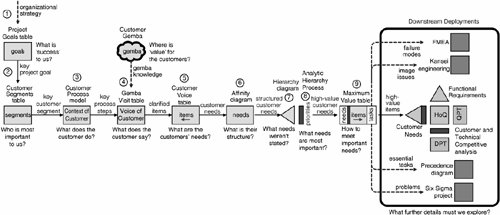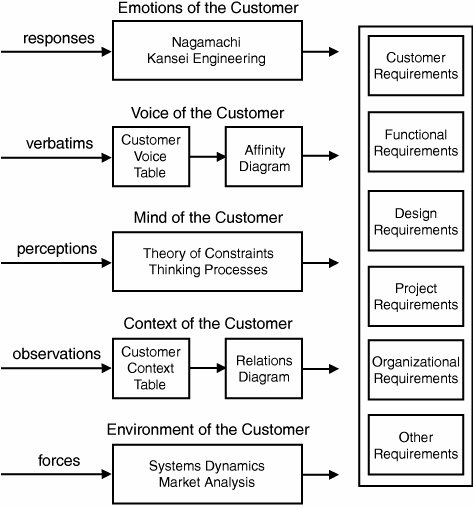Defining Brand-New Needs
| A number of methods for defining customer needs have been tried with QFD over the past decade. Which ones can you use to deal with brand-new products? Methods for Defining Customer NeedsYou can divide the various methods for defining customer needs into five general categories (see Figure 24.3):
Figure 24.3. Methods for defining customer needs for various types of requirements. Each category of method is best suited to developing certain types of products, in certain situations. Let's examine their application to software. Emotions of the CustomerSome methods for defining customer needs concentrate on the affective, or sensory needs of the customer. Kansei Engineering [Nagamachi 1999] is an example of such an approach. You can determine customers' emotional responses by using structured questionnaires and multivariate statistical analyses. Perhaps the best example of a software product that has only emotional value and no functional value is that of a screensaver. Although at one time such software did perform a useful functionthat of preventing burn-in on screensmonitor technology has rendered this original purpose obsolete. So today the value of a screensaver comes from its ability to make the user feel good (by displaying images they like) and look good (by displaying images their peers think are cool). You could use Kansei Engineering to understand the factors of "coolness" and design a "way cool"er set of screen (and other) displays. Kansei Engineering has a solid track record of refining existing products, and you certainly could apply it to a screensaver. Conceivably this could ultimately lead to an entirely new kind of software product that would no longer even be called a screensaver. Games are another attractive software application for Kansei Engineering. BRAND-NEW PRODUCTS: QFD has traditionally been applied to upgrades of existing products. Voice of the CustomerSome methods for defining customer needs concentrate on the customer's statements, or their needs expressed in their own language. The Voice of Customer Analysis within QFD is an example of such an approach [Akao 1990]. Even the most streamlined version of QFD, Blitz QFD [Zultner 1996], is heavily oriented toward Voice of Customer Analysis (see Figure 24.4). Through the use of the Customer Voice Table (CVT), you can translate customer verbatims into customer needssolution-independent benefits that customers want to possess. Then you can organize these customer needs in a natural structure by taking the customer through the KJ Method to produce an Affinity Diagram. At this point, you create the customer needs hierarchy, and analyze, quantify, and prioritize it. This then becomes the left side of the "House of Quality" matrix. Figure 24.4. The "voice of the customer" begins by focusing on which customer(s) we need to satisfy to be successful. There are many examples of Software QFD [Zultner 1994], and some cases of QFD being used to create brand-new software products. For example, one well-known software company developed a new package specifically for one segment of customers: travelers. It was the first product of its kind on the market, and it received good reviews. Another company used QFD to enter a market where there were entrenched competitors. Its first release was chosen "Editors' Choice" at the Milwaukee ASQC Annual Quality Congress ahead of software that had been on the market for years. In this case, the software was familiar to the customer, but it was new to the development organization. Yet the organization was able to build a superior product with its first releaseusing QFD. Mind of the CustomerSome methods for defining customer needs concentrate on the logical, or perceived needs of the customer. The Theory of Constraints (see Sidebar 24.1) [Goldratt 1990] is an example of such an approach. Through the use of the Thinking Processes (the tools of TOC, see Figure 24.5), three questions are addressed: what to change, what to change to, and how to [cause the] change. These questions may be answered with logic, either necessity logic or sufficiency logic. Figure 24.5. The tools of QFD, the Seven Management and Planning (7 MP) Tools, were taken from a variety of disciplines. Although each tool has a specific role to play in the Comprehensive QFD process, most individual QFD projects don't use all the tools. Even for the easiest-to-obtain normal requirements, it is difficult to get more than 80 percent of customer needs by askingeven for familiar products. First (see Figure 24.5), you must analyze the customer's perceived problems, or undesirable effects (UDEs), that make up their current reality, to identify the core problem that causes 80 percent of the perceived problems. Next, the core problem is assumed to result from a core conflict. You examine this conflict, the assumptions behind the conflict surface, and then you break one or more of the assumptions with injections that dissolve the conflict. Then you use the injections as a starting point for a future reality with the undesirable effects turned into desirable effects (DEs), or benefits. Additional injections are often required to complete the model of the future reality to the customer's satisfaction. At this point, some of the injections may require planning to establish intermediate objectives, and their sequence. Finally, some of the injections and/or intermediate objectives may require detailed planning so that you can carry out the transition from the current reality to the desired future reality. There are a number of case studies of companies using TOC to improve an existing product line. The focus on improvement when applying TOC is often on the price, delivery terms, turnaround, or other ways of "tweaking the deal." This is in comparison to QFD, where the focus is often on changing the product or "tweaking the details." TOC attempts to create an "unrefusable offer" (URO) by dissolving and leveraging the core conflict. On some development projects, addressing the core conflict may lie outside the scope of the project. QFD attempts to create a competitive offer by focusing on enough high-value needs to gain a competitive advantage. Those who practice QFD do not even consider whether a core conflict could cause a core problem. So for some QFD development projects, they may be overlooking a major opportunity to add value in an exciting way using TOC techniques. There are many types of requirements, and many methods to obtain them:
And there are many dimensions of product development to which to apply the requirements. Voice of Customer Analysis is a core method of doing QFD. The customer verbatims are converted to needs, structured, inspected, filled in, quantified, prioritized, and used in the "House of Quality" matrix. Several software organizations have used TOC to improve by permanently reducing their elapsed time for development [Zultner 1998], but not to create a brand-new product. Given the potential of the method, it is only a matter of time until this happens. Context of the CustomerSome methods for defining customer needs concentrate on the behavioral, or situational needs of the customer. Customer context analysis [Marsh et al. 1991] is an example of such an approach in QFD. Through the use of a Customer Context table and Relations diagrams, you can analytically uncover customer needs that are required because of the customer's work process [Zultner 1991, Hakos and Redish 1998]. A major CAD vendor applied context analysis to its product, and was able to generate three years' worth of enhancements in one week. Although the vendor provided these features to its customers as enhancements to its existing software, the features were so novel that they could have been packaged as a separate product. To be able to generate this many new customer needs in a mature product is evidence of the power of these methods. One of the traditional principles of QFD is to "go to gemba" and observe directly the place where your product adds value to the customer [McQuarrie 1993]. Even for software, this can lead to customer needs that the customer is unaware ofand a significant competitive advantage for the first firm to find these needs [Beyer and Holtzblatt 1997, Robert et al. 1998]. If you are not going to gemba now, consider doing soeven if just for a day. If you are going now, why not take full advantage of your observations by doing context analysis? Environment of the CustomerSome methods for defining customer needs concentrate on the strategic, or external needs of the customer. Systems dynamics [Senge 1990] is an example of such an approach. Through the use of causal-loop structures and simulation analysis, you can forecast the future states that would lead to new needs. One small software company foresaw that the rapidly decreasing price of hard disks would lead to most people having large amounts of storage available. As a result, everyone would be able to store everything, from all their applications. But could they then find anything? The rather basic facilities available for finding files based on name and file attributes would soon prove inadequate. So this company developed a new kind of software product to track and find a wide variety of information, stored in a wide variety of native application formats. The company conceived the product based on a forecast of needs that would exist once technological and economic forces acted. Currently the company has a successful product that still has no competitors. An example of a software category that possibly could have been realized much earlier is Web auction software. People have held, and attended, garage sales for many years. With the advent of the Internet, it became possible to hold, and attend, a global garage sale. And with more people offering their items for sale than could attend any one physical garage sale, a critical mass was created for people with very specific interests, leading to more items available, more people interested, and more sales. eBay could have happened earlier. The technology was waiting for the need to be recognized. What are some other examples that have yet to be recognized? |
EAN: 2147483647
Pages: 394

